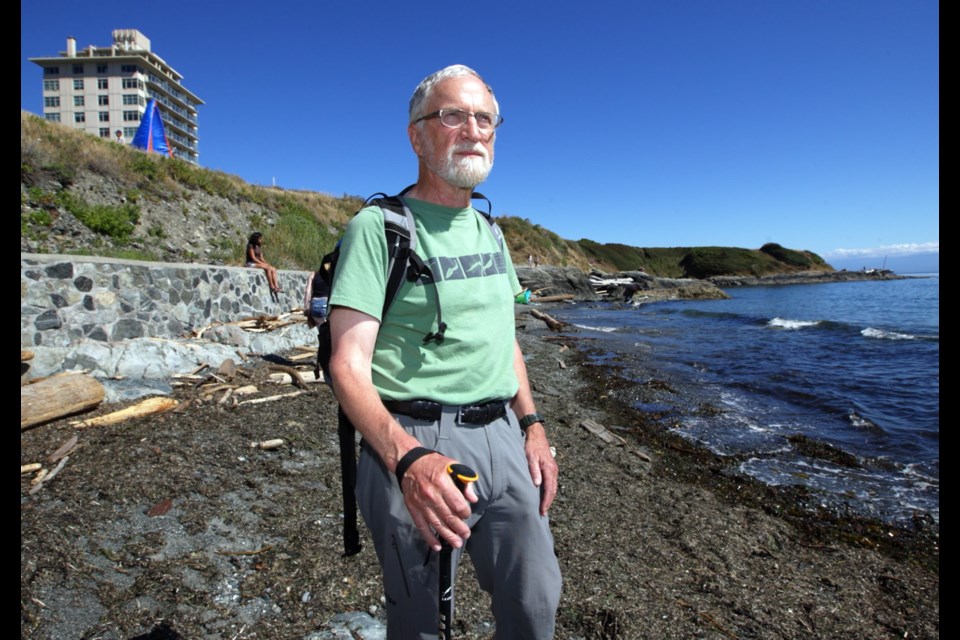Don Kramer was expecting to find one or two dead seabirds when he took a walk on Dallas Road this week.
Rhinoceros auklets have been washing ashore in higher than usual numbers this summer — normally, only one or two are reported in a whole year.
“None of us expected to find eight of them there,” Kramer said of his Thursday walk. “It was shocking.”
Kramer is one of several volunteers patrolling local beaches for dead birds as part of Bird Studies Canada’s Beached Bird Survey.
The non-profit organization has collected 20 carcasses since the end of May and received reports of 11 others.
Across the strait, more than 100 rhinoceros auklets have washed ashore, according to the Coastal Observation and Seabird Survey Team. In a typical year, COASST records two or three.
Bird Studies Canada is sending carcasses to the Canadian Wildlife Service for testing. COASST’s early necropsy results show starvation was a factor — but the cause could be anything from changing ocean conditions, such as toxic algal blooms, to competition with other members of the otherwise healthy colony.
The rhinoceros auklet is a close relative of the puffin. Birder and naturalist Ann Nightingale said it nests in Alaska and migrates south to California. It’s most commonly found on Vancouver Island in the winter months.
The colony based on Protection Island is still hearty, with tens of thousands of members, said Julia Parrish, a University of Washington ecologist and COASST’s executive director.
While the deaths seen so far this year don’t constitute a mass die-off, they are part of a concerning trend toward high seabird deaths that may point to larger environmental changes.
“There’s definitely something going on. That’s the ecosystem screaming: ‘Pay attention!’ ” Parrish said. “The big question is: To what?”
Mass seabird mortalities have risen in the 17 years COASST has monitored them, she said. While they used to occur every four to six years, they now happen almost every year.
Last year, more than 100,000 Cassin’s auklets washed up on shores from northern B.C. to the central California coast, largely due to starvation.
More than 8,000 common murres were found dead in Alaska this winter, also believed starved.
“It’s pretty hard to say, gosh, there’s nothing going on, when pretty much every year now, we’re seeing an unusual mortality event,” Parrish said.
Also concerning, in this case, is the fact that it’s occurring in the Salish Sea. Most mortalities are reported on the outer coast, she said.
“We rarely, rarely see these kinds of events in the inside waters. That’s of concern to us, because it makes us think, is there no safe place?” Parrish said.
It’s possible larger changes in the North Pacific system are creating ecosystem shifts that affect the species’ carrying capacity, predator-prey relationships or other factors, she said.
Karen Devitt, program co-ordinator for Bird Studies Canada, said seabirds can act as canaries in the coal mine.
“Seabirds are an excellent indicator species, because they sit at the top of the food chain. So when there are shifts further down, those changes can manifest further up,” she said.
Most of the rhinoceros auklets washing up on Vancouver Island are concentrated near Dallas Road, Devitt said, but they’ve been found as far north as Tsehum Harbour on the tip of the Saanich Peninsula.
Past seabird deaths have been caused by entanglement with fishing gear, oil spills and plastic ingestion, Devitt said.
If you find a dead bird, don’t touch it. Instead report it the Bird Studies Canada hotline at 1-866-431-2473 or email bcvolunteer@birdscanada.org.



